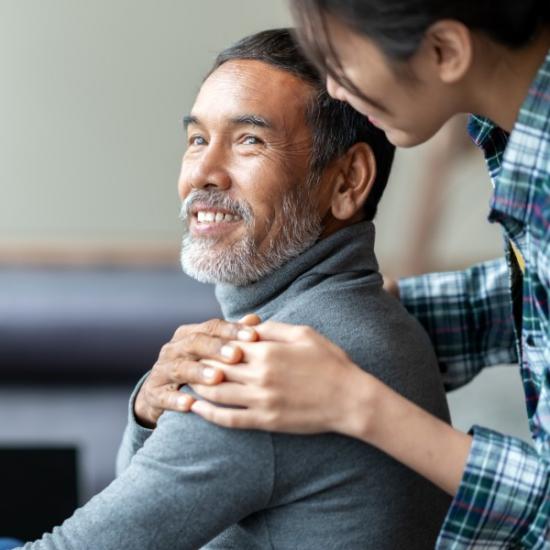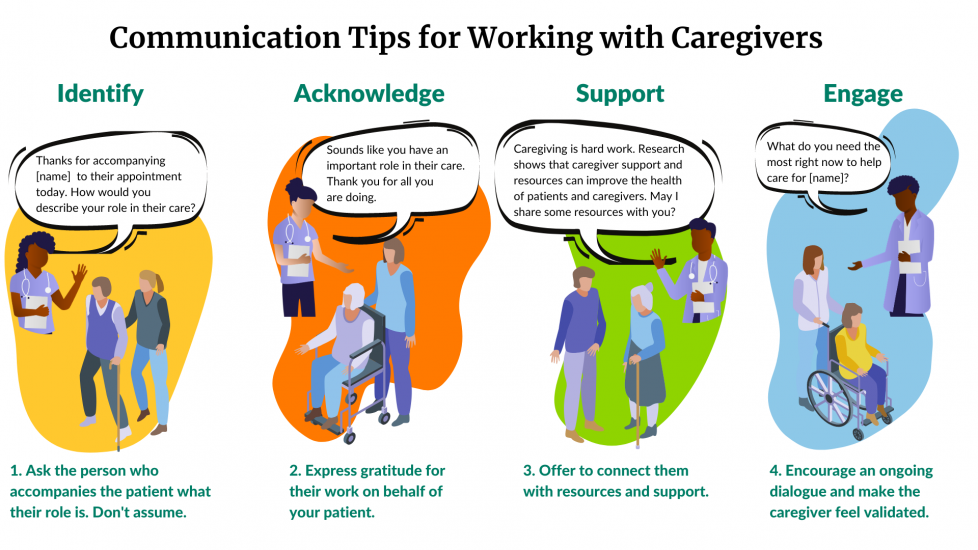Approximately 43.5 million individuals in the US provide informal care to an adult or child, with the vast majority caring for someone age 50 or older. The average caregiver tends to be female, college-educated, middle-aged and employed. However, there are many different kinds of caregivers of all ages and backgrounds. Caregivers are at higher risk for health problems, stress, and depression.*
An informal caregiver refers to any individual providing some form of unpaid and continuous assistance completing activities required of daily life for someone with a chronic illness or disability.
*Source: “Literature Review on the Impact of Informal Caregiving on Healthcare Outcomes Conducted by Division of Governmental Affairs and Public Policy staff for the Health and Public Policy Committee” March 2020
This toolkit shares training, best practices, and resources to help physicians partner with caregivers to improve health outcomes for both patients and caregivers.
Why Engage Caregivers?
 Engaging caregivers is an efficient and effective way to improve the health of both caregivers and patients. Simply identifying your patient’s caregiver and acknowledging their role in the care of your patient can be therapeutic. Sharing resources to inform and support caregivers can be transformative. A recent literature review done by the American College of Physicians found that the simple interventions of identifying caregivers and connecting them with support and training resources can improve the health of both the caregiver and the patient. Patients of trained caregivers were less likely to be hospitalized and trained caregivers had decreased rates of anxiety, depression, and improved quality of life.
Engaging caregivers is an efficient and effective way to improve the health of both caregivers and patients. Simply identifying your patient’s caregiver and acknowledging their role in the care of your patient can be therapeutic. Sharing resources to inform and support caregivers can be transformative. A recent literature review done by the American College of Physicians found that the simple interventions of identifying caregivers and connecting them with support and training resources can improve the health of both the caregiver and the patient. Patients of trained caregivers were less likely to be hospitalized and trained caregivers had decreased rates of anxiety, depression, and improved quality of life.
How to Identify and Acknowledge Informal Caregivers
By identifying and acknowledging a caregiver, the physician may help the caregiver and the patient feel more supported. This takes less than a minute to do!

Testimonial
- Dementia Care Not Just a Prescription - Dr. Catherine DuBeau (ACP Member) is interviewed in an Internist article emphasizing importance in checking in on caregivers.
Videos
- Helping Family Caregivers Through Difficult Situations (video, 5:23) - This video provides advice to physicians on how to better identify and incorporate family caregivers in health care process (specifically in hospital discharge).
- Connecting the Dots for Caregivers - Watch this short video to learn more about ways to have more engaging conversations with caregivers. Caregivers often respond differently to physicians’ questions when they are not in front of the patient.
- Sample of effective communication between a clinician, caregiver, and patient - Effective communication between patients, family members and clinicians can increase understanding of why certain practices are important to follow once the patient leaves the hospital.
How to Connect Caregivers With Resources
 There are many caregiving organizations, networks, alliances, and agencies throughout the US that produce free, high-quality, easily accessible training and support resources. The simple act of sharing a list of relevant websites with a caregiver may encourage them to reach out for help and support and motivate them to enhance their skills. Below are some resources you might consider sharing.
There are many caregiving organizations, networks, alliances, and agencies throughout the US that produce free, high-quality, easily accessible training and support resources. The simple act of sharing a list of relevant websites with a caregiver may encourage them to reach out for help and support and motivate them to enhance their skills. Below are some resources you might consider sharing.
Resources
Use these resources to inform how you provide training to caregivers and share these take home tools with caregivers you come into contact with in practice.

